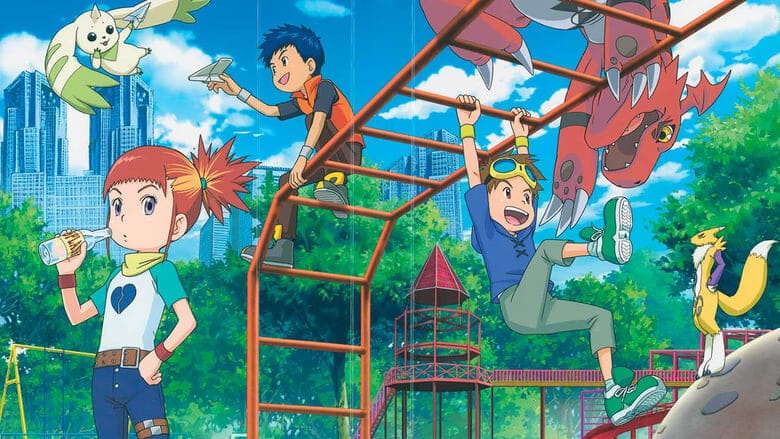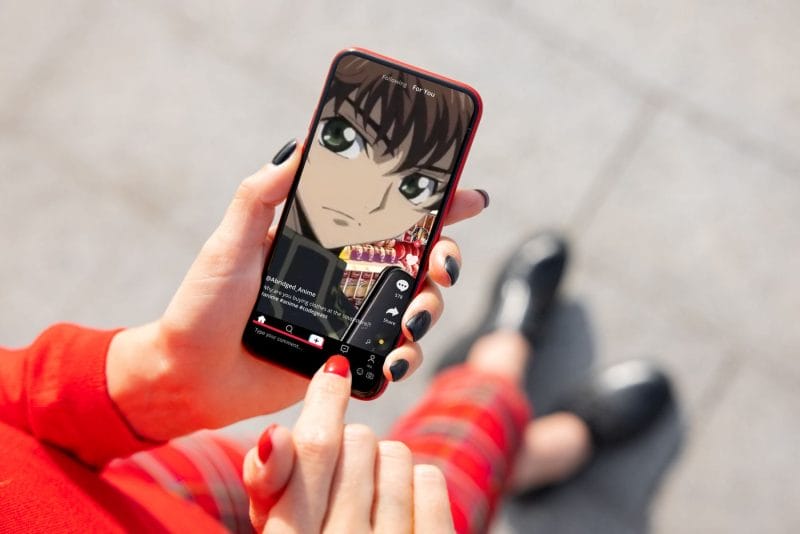Digimon occupies a weird place. It exists in a middle-ground where it never reached the height of its omnipotent contemporary, Pokémon, but also never quite faded into near or total obscurity like many other early kids anime of the time, like Zoids or Monster Rancher. The franchise’s heyday may have been decades ago, but it has still chugged along, thanks to a stream of video game releases, new shows, and now various movies like Digimon Adventure tri and Last Evolution Kizuna, not to mention other upcoming projects. Despite not having a trading card game like it used to, the franchise has endured long enough to start cashing in on its own nostalgia.
Today, though, we’re not looking at Digimon Adventure or its direct follow up Adventure 02. Instead, we’re going to look at the middle-child of the franchise: Digimon Tamers. Tamers is the third iteration of the series, the one that came out right as Digimon reached its cultural zenith outside of Japan, and the one that’s something like Digimon’s Deep Space Nine. Although it was originally met with confusion when it first aired, the series has not only aged well enough to be considered a cult classic, it is even viewed by many Digimon fans as the best entry in the entire franchise.
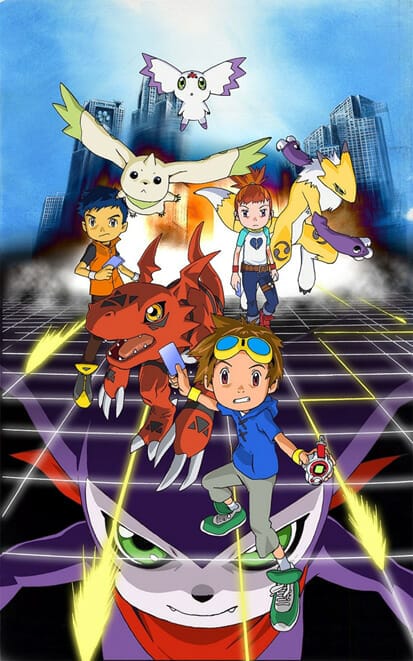
I watched the very first episode of Digimon Tamers when it premiered in 2001, and stuck with it through almost every Saturday morning, right until the end where I (unfortunately) just missed out on the climatic second half of the finale. Tamers was a departure from its two predecessors—while it was still a Digimon series, it had almost no connection to the original Digimon Adventure or its sequel: no returning characters, no mention of previous events, and a darker visual aesthetic from the start. It was a bit of a “change” for seven-year-old me, but I found myself hooked.
Tamers basically hit the reset button for the franchise, and the way its new creative team rebooted the franchise was honestly inspired. While it started from square one with a whole new cast set in a completely different universe, the show treated Digimon pretty much how they were treated in reality at the time. Instead of no one knowing what a Digimon is, they’re a pop culture staple: there’s a Digimon trading card game, video games, and it’s heavily implied that the Agumon that serves as the mascot for (what we know as) Digimon Adventure was a direct influence on one of Tamers’ main characters.
From the first episode, Tamers’ cast know what Digimon are, how they work, and have a rough idea what to expect when you’re partnered with a digital monster. The series—basically a kids’ show—treading such metatextual ground two decades ago hits better now than it did during its initial airing. This creative choice not only allowed the show to skip over a bunch of details the audience already knew about, it also served as a key factor to what sets Tamers apart from the rest of the franchise: specifically, its role as a deconstruction of the very series it’s meant to sell toys for.
Watching the show today, it’s apparent that Tamers has numerous, rough edges. The animation is fairly basic, and the way it was localized and dubbed added many, many corny jokes. Beyond these minor issues, though, Tamers’ better qualities quickly come to light.
From its visual style, to its storytelling, to its characterization, Tamers is a much more grounded and generally realistic experience than the previous two shows. Digimon Adventure and 02 both had big casts, but the majority of the shows’ characters were based on simple archetypes. Occasionally, there would be glimpses of development beyond the expected “learning to trust and work with your friends,” a highlight of which being Ken of 02 having an arc that follows his evolution from the malevolent Digimon Emperor to a repentant hero.
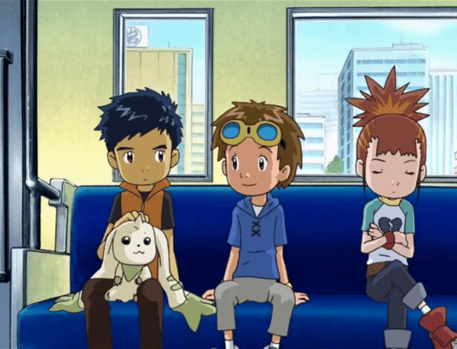
Tamers, meanwhile, traded quantity for quality, slimming the main cast down from eight children down to just three, each of whom start out with detailed backstories They all see character growth from the first episode, and continue to change through the end of the series’ fifty-one episode run.
Henry Wong, for example, is weary of his own reckless past, leading to a deep desire to avoid fighting at any cost. Rika Nonaka, on the other hand, is a card game champion who views a Digimon’s value as strictly proportional to its power. Takato Matsuki, meanwhile, serves as an analog for the audience—a Digimon nerd who starts out wanting a Digimon partner because they look cool.
From this aspect, the Digimon each Tamer is paired with serves as an ideal complement. Terriermon is a lighthearted joker and a foil to Henry’s serious demeanor. The cool and collected Renamon, on the other hand, is an antithesis to Rika, who would rather shoot first and ask questions later. It’s these contrasts between the Tamers and their Digimon that drive the plot and spur character growth. Each conflict, each experience as these children live with their Digimon friends, helps both parties learn what it really means to be a tamer or a Digimon. But, more importantly, it teaches them about what it means to be a partner.
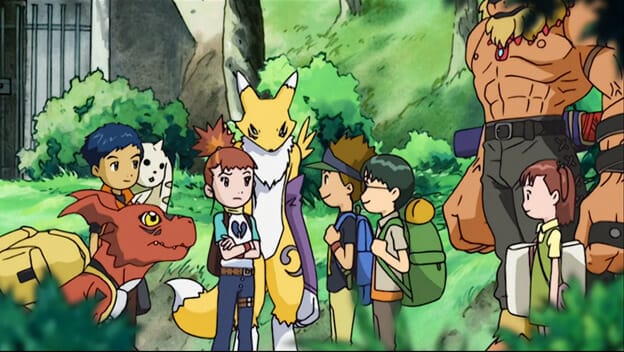
It’s not just the show’s protagonists that give the series its edge, though. Tamers’ antagonists often serve dual roles, both as obstacles to overcome, and as storytellers of a sort in their own right: they flesh out the show’s setting while organically laying the groundwork for future story arcs. One could argue that villains sometimes fulfilled a similar role in previous entries in the franchise. For instance, some antagonists like Black War Greymon had layered personal motivations, while others, like Myotismon, were just deliciously evil. These proved to be exceptions to the rule, though, as most baddies were introduced and promptly dispatched.
In Tamers however, each antagonist serves to drive the plot to its next logical phase. The first is the mysterious human Yamaki, who starts out wanting to exterminate Digimon for the safety of the human world, only to inadvertently open a portal that allows even more dangerous Digimon to invade. Said dangerous Digimon are the so-called Devas, who are vanguards sent by an even higher power to kidnap a mysterious Digimon who befriended the Tamers. This, in turn, leads the protagonists to finally cross over to the digital world for the first time.
In this light, Digimon Tamers truly feels like the first Digimon series that was planned out from the get-go. The series ultimately culminates in a final showdown against an antagonist that was uncharted territory for the franchise at the time: the digital program D-Reaper, the first antagonist in the franchise that is neither Digimon nor human.
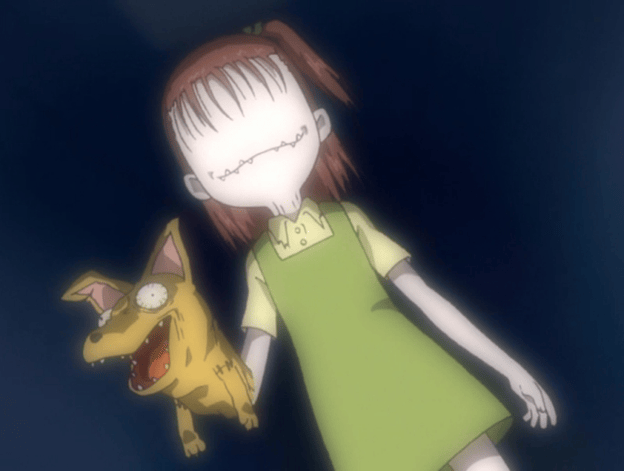
D-Reaper was originally a program designed as a virtual custodian, erasing digital programs that became overly complicated. But, as Digimon became more complex, so did it, to the point where it mutated into what is effectively a natural disaster for the digital world. Worse still, it ends up invading the human world. D-Reaper’s impact ultimately led to Tamers’ reputation for surreal creatures and scenes that border on nightmare fuel. The entity also led to defining moments for two of the show’s minor characters: the annoying Impmon, and Takato’s friend Jeri.
Impmon traded his soul in a pursuit for power, leading him to become the mega-level Beelzemon. In exchange, he was charged with eliminating the Tamers. While Beelzemon ultimately failed, he still killed Jeri’s partner Leomon, which sent her into a depressive state. The trauma and her subsequent depression left Jeri vulnerable to being absorbed by the D-Reaper, thus allowing it to cross over into the human world. The entire experience results in a nightmarish catastrophe that is evocative of Neon Genesis Evangelion. This leads to what is easily the most heartbreaking scene in all of Digimon Tamers, in which Beelzemon attempts to redeem himself by saving Jeri from the D-Reaper, only to have his efforts be in vain.
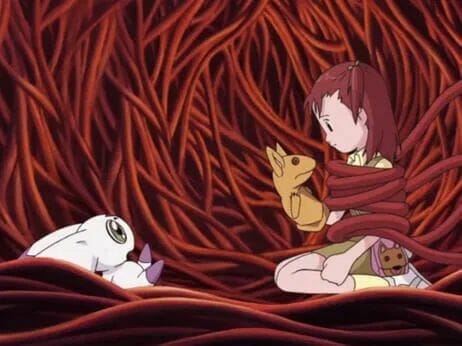
From this perspective, it feels almost perfect that a series built around exploring the idea of children growing stronger by working with their partners has its final conflict center on a kid losing their partner, and subsequently find herself down a pit of despair. It’s these character-based, deeply motivated conflicts that elevate the villains from simple narrative devices, and round out a cast of genuinely interesting characters with genuine pathos. It’s a repudiation of the idea that something designed to sell toys cannot aspire to something genuinely meaningful or complex.
Though Digimon Adventure and its sequel are receiving feature films to ring in their anniversaries, Tamers still has yet to escape from its reputation as a black sheep. Digimon Tamers did receive a stage show on August 1, 2021, as part of the “DigiFest 2021” event. The show, which was written by Digimon Tamers writer Chiaki Konaka, was intended to be a (albeit non-canon) modern-day sequel, which reunited much of the original Japanese cast. The show quickly became mired in controversy, though, as the story awkwardly featured numerous politically charged themes, with “political correctness” and “cancel culture” being cast as the main villains. Moreover, this brought attention to Konaka’s personal blog, in which he espoused support for conspiracy theories surrounding the COVID-19 pandemic. Even during the one bone it was thrown in recognition, Tamers wasn’t able to catch a break.
Sometimes, revisiting a childhood favorite can be embarrassing. Thankfully, Digimon Tamers has mostly withstood the test of time, thanks to its original gambles on darker and more involved storytelling. Twenty years later, the series is even more special than it was when it first aired on televisions worldwide, and with each year that passes, its accomplishments only become more and more impressive.


